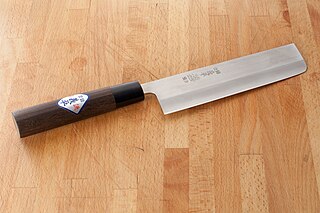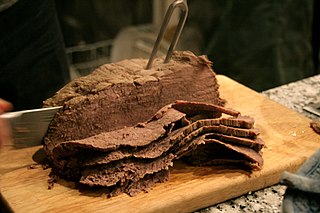This article needs additional citations for verification .(May 2014) |

A butcher knife or butcher's knife is a knife designed and used primarily for the butchering or dressing of animal carcasses.
This article needs additional citations for verification .(May 2014) |

A butcher knife or butcher's knife is a knife designed and used primarily for the butchering or dressing of animal carcasses.
Today, the butcher knife is used throughout the world in the meat processing trade. The heftier blade works well for splitting, stripping and cutting meat. Other similar meat-cutting knives include the carving knife and the cleaver. The carving knife is usually designed for slicing thin cuts of meat and often has a blunt or rounded point, with a scalloped or Granton blade to improve separation of sliced cuts of meat. The cleaver is similar to the butcher's knife, but has a lighter and thinner blade for precision cutting.

From the late 18th century to the mid-1840s, the butcher knife was a key tool for mountain men. Simple, useful and cheap to produce, they were used for everything from skinning beaver, cutting food, self-defense, and scalping. During this time, John Wilson, of Sheffield, England, was a major exporter of this type of knife to the Americans. [1] These knives can be identified by brand markings and the stamp I. Wilson. [2] Heavy cleavers were traditionally hung up on a hook for ease of access.

A utility knife is any type of knife used for general manual work purposes. Such knives were originally fixed-blade knives with durable cutting edges suitable for rough work such as cutting cordage, cutting/scraping hides, butchering animals, cleaning fish scales, reshaping timber, and other tasks. Craft knives are small utility knives used as precision-oriented tools for finer, more delicate tasks such as carving and papercutting.

A knife is a tool or weapon with a cutting edge or blade, usually attached to a handle or hilt. One of the earliest tools used by humanity, knives appeared at least 2.5 million years ago, as evidenced by the Oldowan tools. Originally made of wood, bone, and stone, over the centuries, in step with improvements in both metallurgy and manufacturing, knife blades have been made from copper, bronze, iron, steel, ceramic, and titanium. Most modern knives have either fixed or folding blades; blade patterns and styles vary by maker and country of origin.

A blade is the sharp, cutting portion of a tool, weapon, or machine, specifically designed to puncture, chop, slice, or scrape surfaces or materials. Blades are typically made from materials that are harder than those they are intended to cut. This includes early examples made from flaked stones like flint or obsidian, evolving through the ages into metal forms like copper, bronze, and iron, and culminating in modern versions made from steel or ceramics. Serving as one of humanity's oldest tools, blades continue to have wide-ranging applications, including in combat, cooking, and various other everyday and specialized tasks.

A Bowie knife is a pattern of fixed-blade fighting knife created by Rezin Bowie in the early 19th century for his brother James Bowie, who had become famous for his use of a large knife at a duel known as the Sandbar Fight.

A Japanese kitchen knife is a type of kitchen knife used for food preparation. These knives come in many different varieties and are often made using traditional Japanese blacksmithing techniques. They can be made from stainless steel, or hagane, which is the same kind of steel used to make Japanese swords. Most knives are referred to as hōchō or the variation -bōchō in compound words but can have other names including -kiri. There are four general categories used to distinguish the Japanese knife designs: handle, blade grind, steel, and construction.

Usuba bōchō is the traditional vegetable knife for the professional Japanese chef. Like other Japanese professional knives, usuba are chisel ground, and have a bevel on the front side, and have a hollow ground urasuki on the back side. Usuba characteristically have a flat edge, with little or no curve, and are tall, to allow knuckle clearance when chopping on a cutting board. Usuba literally means "thin blade" indicating its relative thinness compared to other knives, required for cutting through firm vegetables without cracking them. Due to its height and straight edge, usuba are also used for specialized cuts such as katsuramuki, shaving a vegetable cylinder into a thin sheet.

Meat carving is the process and skill of cutting portions of meat, such as roast and poultry, to obtain a maximum or satisfactory number of meat portions, using a carving knife or meat-slicing machine. A meat carver disjoints the meat and slices in uniform portions. Meat carving is sometimes considered a skill for the private dinner table.

A kitchen knife is any knife that is intended to be used in food preparation. While much of this work can be accomplished with a few general-purpose knives – notably a large chef's knife, a tough cleaver, a small paring knife and some sort of serrated blade – there are also many specialized knives that are designed for specific tasks. Kitchen knives can be made from several different materials.
In cooking, a chef's knife, also known as a cook's knife, is a cutting tool used in food preparation. The chef's knife was originally designed primarily to slice and disjoint large cuts of beef. Today it is the primary general-utility knife for most Western cooks.

The Santoku bōchō or Bunka bōchō (文化包丁) is a general-purpose kitchen knife originating in Japan. Its blade is typically between 13 and 20 cm long, and has a flat edge and a sheepsfoot blade that curves down an angle approaching 60 degrees at the point. The term Santoku may refer to the wide variety of ingredients that the knife can handle: meat, fish and vegetables, or to the tasks it can perform: slicing, chopping and dicing, either interpretation indicating a multi-use, general-purpose kitchen knife. The Santoku's blade and handle are designed to work in harmony by matching the blade's width and weight to the weight of the tang and the handle.
X-Acto is a brand name for a variety of cutting tools and office products owned by Elmer's Products, Inc. These include hobby and utility knives, saws, carving tools and many small-scale precision knives used for crafts and other applications. An X-Acto knife may be called an Exacto knife, utility knife, precision knife, or hobby knife.

Sharpening is the process of creating or refining the edge joining two non-coplanar faces into a converging apex, thereby creating an edge of appropriate shape on a tool or implement designed for cutting. Sharpening is done by removing material on an implement with an abrasive substance harder than the material of the implement, followed sometimes by processes to polish/hone the sharp surface to increase smoothness.

A cleaver is a large knife that varies in its shape but usually resembles a rectangular-bladed hatchet. It is largely used as a kitchen or butcher knife and is mostly intended for splitting up large pieces of soft bones and slashing through thick pieces of meat. The knife's broad side can also be used for crushing in food preparation and can also be used to scoop up chopped items.

A hunting knife is a knife used during hunting for preparing the game to be used as food: skinning the animal and cutting up the meat. It is different from the hunting dagger which was traditionally used to kill wild game.

A cheese knife is a type of kitchen knife specialized for the cutting of cheese. Different cheeses require different knives, according primarily to hardness. There are also a number of other kitchen tools designed for cutting or slicing cheese, especially the harder types. These include the cheese cutter, cheese slicer, cheese plane, cheese scoop for soft cheese and others, collectively known as cheese servers.
A cimeter or scimitar is a large, curved butcher's knife, with a blade typically 8–14" (20–35 cm) long. It is used primarily for cutting large pieces of meat into retail cuts such as steaks. These knives are available with and without a granton edge. According to Webstaurant Store, a major supplier to the food industry, "Granton edge knives feature hollowed out sections running along both sides of the blade. When slicing meat, the grooves fill with fat and juices, which permits less contact between the meat and blade. Granton edge knives are often preferred for slicing thin portions of poultry, roasts, or ham."

A fillet knife is a kitchen knife used for filleting. It gives good control and aids in filleting. It is a very flexible member of the boning knife family that is used to filet and prepare fish. Fillet knife blades are typically 15 to 28 cm long. This allows them to move easily along the backbone and under the skin of meat.

Knife indentation is done away from the edge of a kitchen knife. A knife most simply has either a rectangular or wedge-shaped cross-section, but may also have indentations, whose purpose is to reduce adhesion of the food to the blade. This is widely found in Japanese knives, and in the West is particularly found in meat carving knives, though also in knives for soft cheese, and some use for vegetables.
Beaver Falls Cutlery Company, Beaver Falls, Pennsylvania, is a former company which manufactured steel cutlery, razors and pocketknives. The company was founded as Binns & Mason in 1866 by skilled cutlers from Sheffield, West Riding of Yorkshire, England, as a small enterprise making pocketknives in Rochester, Pennsylvania, then it briefly became The Pittsburgh Cutlery Company. It was purchased in 1867 by the Harmony Society, brought to Beaver Falls, and developed for mass production, to employ 300 people and to cover a two-acre site. In 1872 it suffered a labor dispute which was resolved by the employment of up to 225 Chinese workers. In 1876 it produced the "largest knife and fork in the world," of its time, for display at the Centennial Exposition. The company closed in 1886.

A Chinese chef's knife — sometimes referred to as a Càidāo, a Chinese cleaver or a "chopper", is the rectangular-bladed, all-purpose cooking knife traditionally used in China, Vietnam, Cambodia and many other Asian countries to prepare a variety of meats, fish and vegetables. The popularity of this style of knife has spread with the associated cuisines. They resemble Western cleavers in appearance, but most Chinese chef's knives are relatively thin-bladed and designed for slicing, finely chopping and mincing vegetables, fish and boneless meats. The heavier gǔdāo are produced and are used much like Western-type meat cleavers to prepare large sides of beef, pork and other boned meats. However, Chinese-style knives of this weight are not common in the West.